The national flag of Uganda is a striking and deeply symbolic emblem that encapsulates the nation's unique identity, rich history, and aspirations for peace and prosperity. Adopted on October 9, 1962, the very day Uganda gained its independence from British colonial rule, the flag was designed by Grace Ibingira, who was then the Minister of Justice. Its design reflects a blend of traditional African symbolism and a forward-looking vision for a unified and progressive nation.
Design and Symbolism: A Palette of Pride
The flag of Uganda features six alternating horizontal stripes of black, yellow, and red, repeated twice, from top to bottom. At the center of the flag, superimposed on a white disc, is the national symbol: a Grey Crowned Crane ( Balearica regulorum ), facing the hoist side with one leg raised. Each color and the central emblem hold profound meaning:
-
Black Stripes: The uppermost and third horizontal stripes are black. This color universally represents Africa and, more specifically, the African people of Uganda. It symbolizes the nation's rich heritage, its connection to the continent's diverse cultures, and its determination to forge its own destiny. Black also signifies the unique and fertile soil of Uganda, a source of life and sustenance for its people.
-
Yellow Stripes: The second and fourth horizontal stripes are yellow. This vibrant color signifies Uganda's abundant sunshine and the warmth of its people. Uganda is known for its equatorial climate, with sunshine year-round, which is crucial for its agricultural productivity and lush landscapes. Yellow also reflects the nation's hope for a prosperous future, drawing on its natural resources and the industriousness of its citizens.
-
Red Stripes: The lowest and fifth horizontal stripes are red. This powerful color represents African brotherhood and the blood that binds all Africans. It symbolizes the spirit of unity, fraternity, and the collective struggle for freedom and self-determination. Red also evokes the sacrifices made by those who fought for Uganda's independence, underscoring the value of national cohesion.
-
White Disc: The circular white disc at the flag's center provides a neutral background, highlighting the national emblem. White traditionally symbolizes peace and purity, representing the clear, unblemished path that Uganda sought to embark upon at the dawn of its independence. It signifies a fresh start, free from colonial influence, and a commitment to peaceful coexistence among its diverse communities.
-
Grey Crowned Crane: The most distinctive feature of the flag is the Grey Crowned Crane, a beautiful and elegant bird native to Uganda. This crane is the national bird of Uganda and holds deep cultural significance. Facing the hoist, its raised leg symbolizes Uganda's forward movement, its progress, and its readiness to move ahead into the future. The crane itself is a gentle bird but also known for its vigilance and peaceful nature. It was adopted as a symbol by the British colonialists on their military crest but was retained by independent Uganda to symbolize foresight, peace, and national pride. Its presence on the flag underscores Uganda's natural beauty and biodiversity.
Dimensions and Proportions:
The official proportions of the Ugandan flag are typically 2:3 (height to width). The six horizontal stripes are of equal width, ensuring visual balance. The white disc is centered, and the crane is proportionally sized to be clearly visible and prominent without overwhelming the striped background. The precise positioning and rendering of the crane are crucial for maintaining the integrity of the design.
History and Evolution: From Colony to Nation
Before its independence, Uganda, as a British Protectorate, primarily flew the British Blue Ensign, defaced with the colonial badge that featured a Grey Crowned Crane on a green mound. As the move towards independence gained momentum in the late 1950s and early 1960s, there was a growing desire for a distinct national symbol.
The design of the current flag emerged from a competition held in the lead-up to independence. Grace Ibingira, then a prominent lawyer and politician within the Uganda People's Congress (UPC), submitted the winning design. His concept effectively incorporated elements that represented Uganda's African identity, its natural environment, and its aspiration for unity.
The flag was officially hoisted for the first time on October 9, 1962, replacing the British ensign and marking a momentous occasion in Uganda's history. It has remained unchanged since then, a testament to its enduring relevance and widespread acceptance across various political regimes and societal shifts. Despite periods of intense political turmoil and internal conflict, the flag has consistently served as a unifying emblem, embodying the resilience and continuity of the Ugandan state.
Regional Context and Pan-Africanism:
Uganda is a landlocked country in East Africa, bordering Kenya, South Sudan, the Democratic Republic of Congo, Rwanda, and Tanzania. Its flag's use of black, yellow, and red – colors often associated with Pan-Africanism and liberation movements across the continent – aligns with the broader post-colonial spirit that swept through Africa in the mid-20th century. While not explicitly a Pan-African flag, its color scheme subtly resonates with the themes of African unity and self-determination. The flag design, particularly with the central emblem, distinguishes it from other African flags, while the colors echo shared aspirations for freedom and prosperity common to the region.
Interesting Facts:
-
Designed by a Minister: Unlike many flags whose designers remain anonymous or are part of a committee, Uganda's flag was specifically designed by a cabinet minister, Grace Ibingira.
-
National Bird Symbolism: The Grey Crowned Crane is a truly iconic bird of Uganda. Its inclusion signifies not just national pride but also an emphasis on the country's rich biodiversity and natural heritage.
-
Symbol of Vigilance: The crane's raised leg is often interpreted as a symbol of the nation's vigilance and readiness to defend itself, even though the bird itself is gentle.
-
Pre-Independence Use of Crane: The crane was already featured on Uganda's colonial badge, suggesting a continuity of a recognized national symbol even before full independence.
-
Colors with Specific Meanings: The clear breakdown of what each color represents makes the flag's symbolism easily understood and remembered by the populace.
Significance for the Inhabitants: A Beacon of Identity and Unity
For the people of Uganda, the national flag is much more than a piece of fabric; it is a profound symbol of their nationhood, their hard-won independence, and their collective aspirations. It embodies their journey from colonial subjugation to self-governance.
In a country as diverse as Uganda, with numerous ethnic groups and languages, the flag serves as a crucial unifying element. It represents the shared identity of all Ugandans, transcending tribal and regional differences. During national holidays such as Independence Day (October 9th), Liberation Day (January 26th), and other patriotic events, the flag is proudly displayed across homes, public buildings, and vehicles.
The sight of the flag evokes feelings of patriotism, national pride, and a sense of shared destiny. It reminds Ugandans of the sacrifices made to achieve independence and the ongoing commitment required to build a prosperous and peaceful nation. The Grey Crowned Crane, in particular, resonates deeply, connecting the people to their land's unique natural beauty and the values of peace and vigilance. The flag stands as a constant reminder of Uganda's sovereignty and its place among the nations of the world, fostering a sense of belonging and collective responsibility among its citizens. It is a source of hope and inspiration, representing the resilience and vibrant spirit of the Pearl of Africa.
In the demonstration images, full-size flags are shown with proportions of 2:3, and hand-held flags with proportions of 1:2.
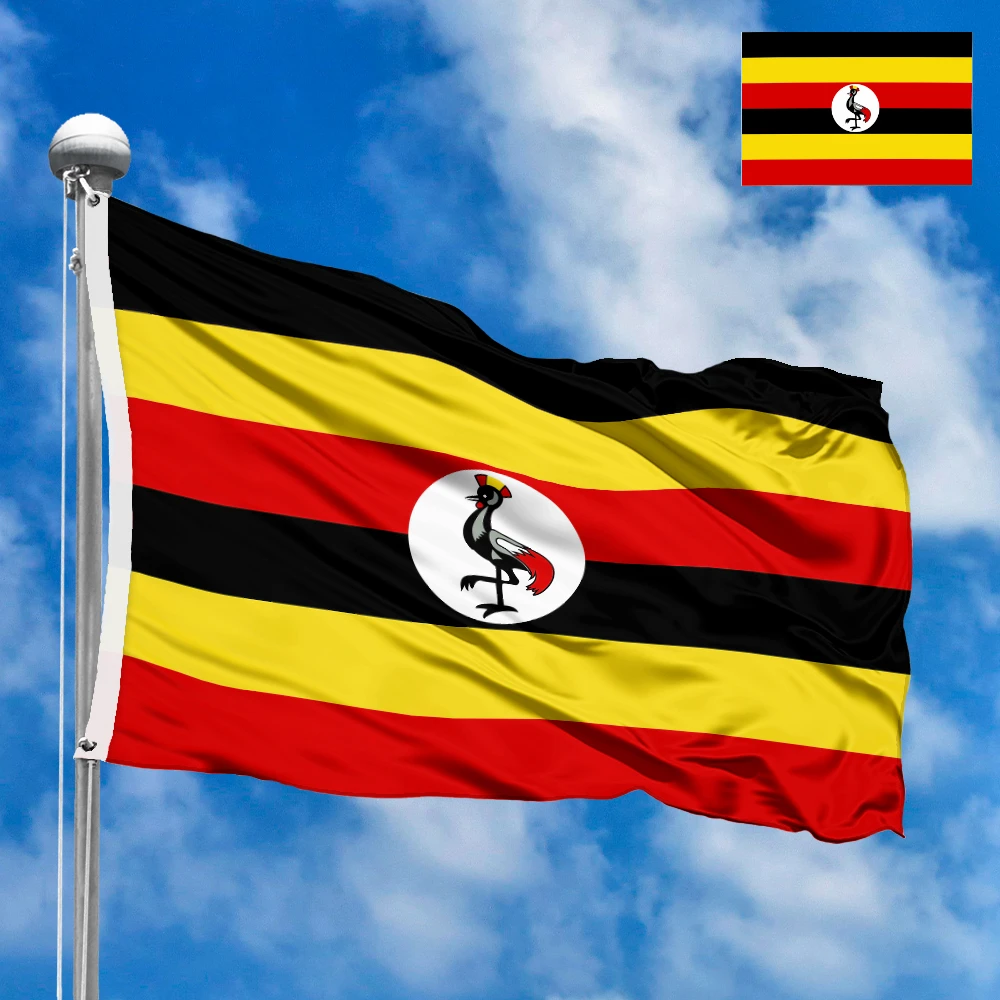

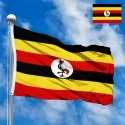
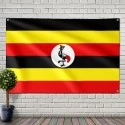
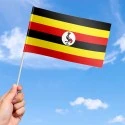
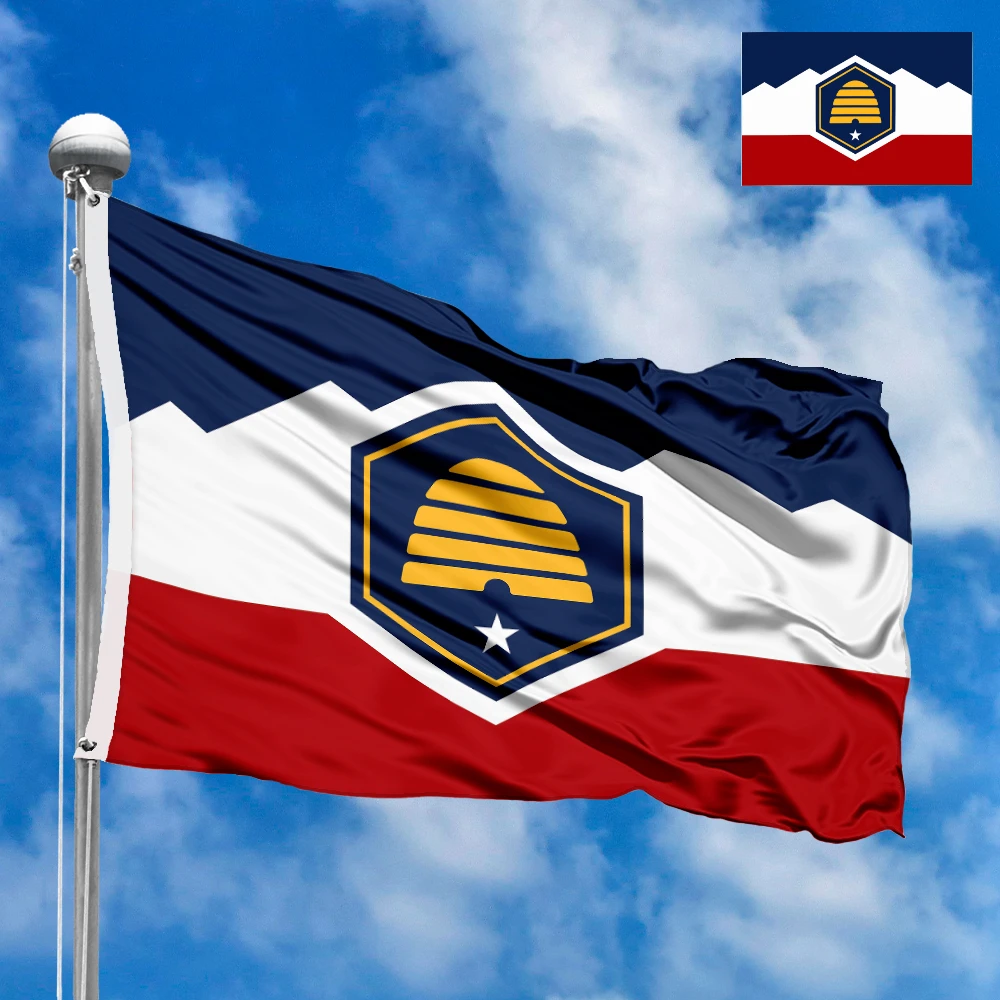


 Waving flag
Waving flag
 Sizes:
Sizes:
 Round flag
Round flag
 Sizes:
Sizes:
 Rectangular flag 2:3
Rectangular flag 2:3
 Sizes:
Sizes: